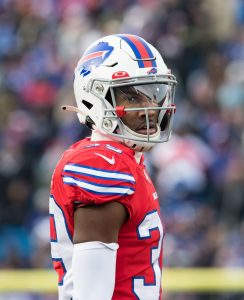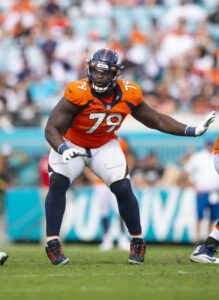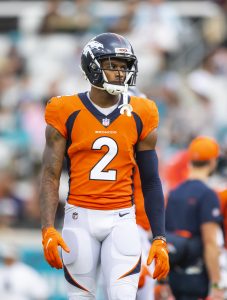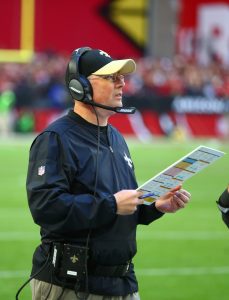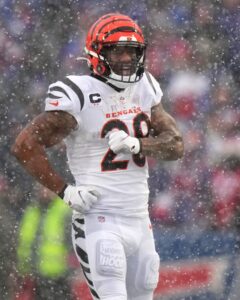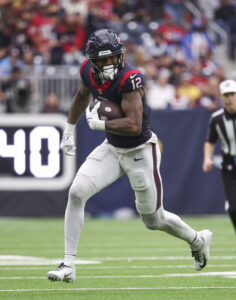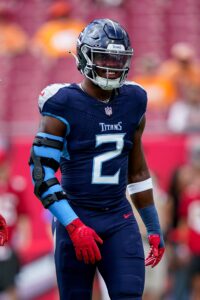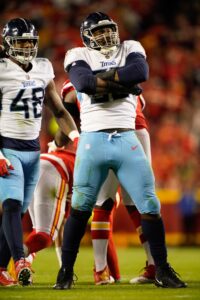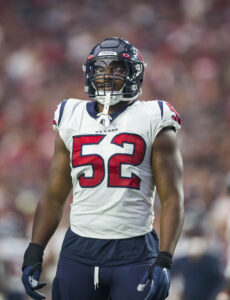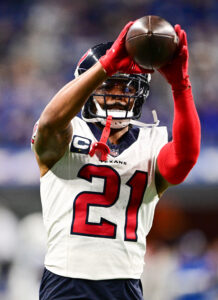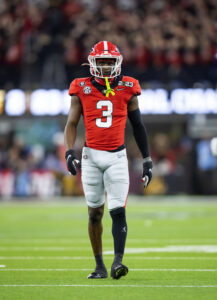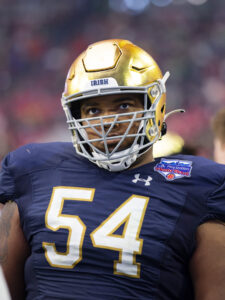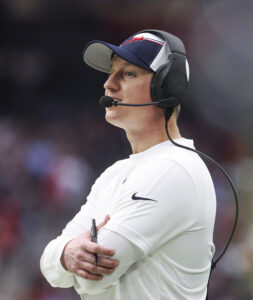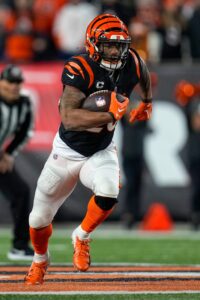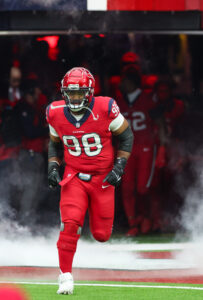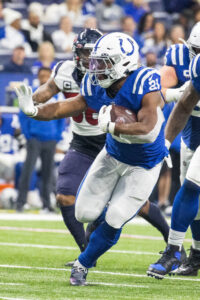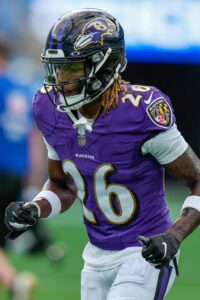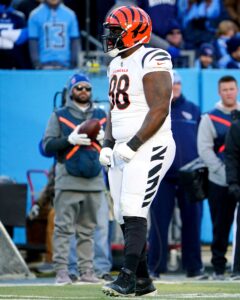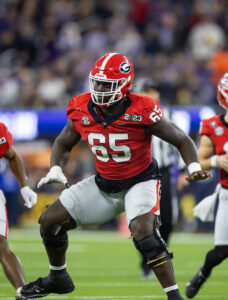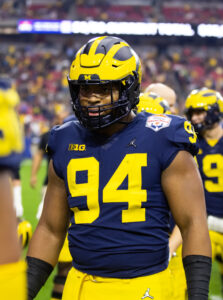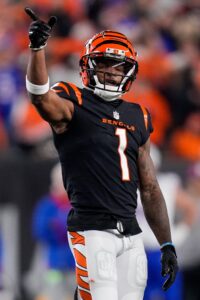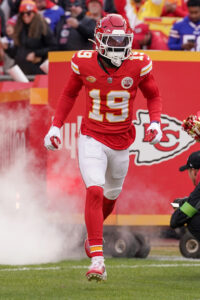The Colts nearly turned a seemingly lost season into a playoff berth, falling just short of an AFC South title despite Gardner Minshew needing to replace Anthony Richardson early. Indianapolis responded to its 9-8 showing by displaying tremendous confidence in Chris Ballard‘s homegrown core, one that has largely been around as the team has cycled through post-Andrew Luck quarterback options. A spree of extensions and re-signings defined Indy’s offseason; well, that and Richardson’s rehab effort.
While last season marked a surprise surge, it also still brought few answers on the gamble the team took at No. 4 overall. Richardson entered the NFL as a raw prospect with tantalizing tools; his run of injuries last year brought obvious concerns. More importantly, the Florida product threw 84 passes after a 393-pass Gators career. The Colts need the dual-threat QB to show signs he will be the long-awaited post-Luck long-term QB. Some of Luck’s teammates are still in the picture in Indy, illustrating how far back Ballard’s core goes. The team continued its build-from-within strategy this offseason.
Extensions and restructures:
As injuries caught up with T.Y. Hilton, Pittman quickly became the Colts’ lead wideout. The 2020 second-rounder had operated as such for most of his career, and while the Colts resolved the Jonathan Taylor matter before taking care of Pittman, the franchise tag made a rare appearance in Indianapolis to ensure the two-time 1,000-yard receiver could not test the market. Using the tag for the first time since cuffing Pat McAfee in 2013, the Colts slapped a $21.8MM tender on Pittman. Unlike the Bengals, who are renting Tee Higgins for at least one more season, Pittman — chosen one spot after Higgins in the 2020 second round — signed an extension just before the legal tampering period opened.
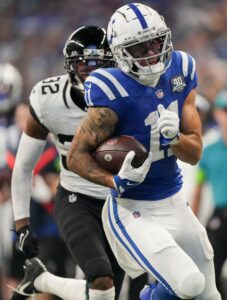 Pittman’s extension moved the $21.8MM number off the Colts’ books, freeing them up to execute a retention-heavy free agency strategy. The Colts also did well, as it turned out, by not letting negotiations drag near the July 15 deadline.
Pittman’s extension moved the $21.8MM number off the Colts’ books, freeing them up to execute a retention-heavy free agency strategy. The Colts also did well, as it turned out, by not letting negotiations drag near the July 15 deadline.
Indy extending Pittman on March 11 came just before Calvin Ridley scored a four-year, $92MM deal ($46.98MM fully guaranteed) and weeks before Amon-Ra St. Brown‘s extension confirmed another market boom was coming. Pittman, 26, was not a candidate to rival A.J. Brown and Justin Jefferson‘s $32MM- and $35MM-per-year extensions, but the fifth-year Colt would have benefited by the WR ceiling rising had those transactions occurred before his.
The Colts convincing Pittman, shortly after news of the cap’s $30.6MM spike emerged, to do a deal south of where 2022 extension recipients Deebo Samuel and D.K. Metcalf reside proved a win for the team. Following the St. Brown and Jefferson pacts, along with Nico Collins‘ $24MM-per-year deal, Pittman sits as the NFL’s 14th-highest-paid wideout. CeeDee Lamb and Brandon Aiyuk figure to affect that placement soon, but via the short-term extension, Pittman should have a chance at another big payday in his late 20s.
Richardson’s injury probably helped Pittman contractually. The raw rookie likely would not have been able to set up Pittman for the season he had — 109 catches, 1,152 yards — but Minshew peppered the 6-foot-4 weapon with targets to help the Colts’ surprising run to the postseason precipice. The Colts strengthened their receiving corps in the draft, but Richardson will be looking Pittman’s way first as the team enters its second season under Shane Steichen.
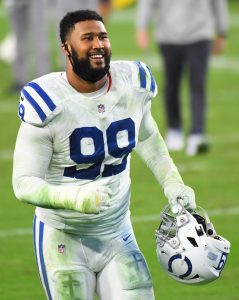 After Indianapolis’ binge of agreements with homegrown talent, Ballard extended the D-line centerpiece he acquired via trade four years ago. Obtained for a 2020 first-round pick, Buckner has remained one of the NFL’s best defensive tackles. While the 49ers cut Arik Armstead four years after choosing his slightly cheaper extension over a Buckner re-up back in 2020, the latter is still going strong in Indiana.
After Indianapolis’ binge of agreements with homegrown talent, Ballard extended the D-line centerpiece he acquired via trade four years ago. Obtained for a 2020 first-round pick, Buckner has remained one of the NFL’s best defensive tackles. While the 49ers cut Arik Armstead four years after choosing his slightly cheaper extension over a Buckner re-up back in 2020, the latter is still going strong in Indiana.
Buckner, 30, scored a deal that comes nearly fully guaranteed. He moved from $21MM per year to $23MM on average, and while his current AAV sits seventh among DTs, the former top-10 pick traded a push for a top-market salary for security. Buckner’s 2024 and ’25 base salaries are fully guaranteed, and the Colts have the Oregon alum on the books through his age-32 season.
A two-time Pro Bowler as a Colt — in addition to receiving a 2020 first-team All-Pro nod — Buckner has missed one game since being traded. The Colts will hope to continue to rely on a player who has anchored their D-line during a period of edge rusher uncertainty. Buckner’s presence boosted the development of Kwity Paye and Dayo Odeyingbo, both of whom making progress en route to career-high sack totals last season. Buckner’s four-year Colts sack count (32.5) betters his four-season 49ers work (28.5), and his 87 QB hits with the AFC team outflank his San Francisco total as well.
Totaling between seven and 9.5 sacks during his Colts tenure, Buckner gives the team a high floor that will certainly be important as the team attempts to load up around Richardson. Pro Football Focus has slotted Buckner as a top-12 DT in three of his four Indy seasons, and ESPN’s pass rush win rate metric tabbed him fifth among interior D-linemen last season. This near-fully guaranteed contract shows one of the luxuries a rookie-scale QB provides for a franchise.
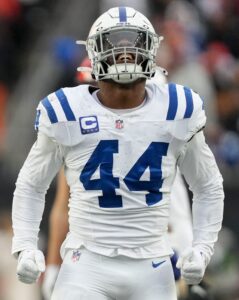 As Shaquille Leonard‘s injuries mounted to the point the perennial All-Pro became a late-season release last year, the Colts leaned on Franklin. The latter’s latest agreement came two years after the Colts had re-signed the former seventh-rounder to a three-year, $10MM deal. A Syracuse product, Franklin adds to Ballard’s breakthrough 2018 draft haul. The ’18 group played a key role in the Colts reigniting after a miserable Andrew Luck-less 2017, with Leonard, Quenton Nelson, Braden Smith, Nyheim Hines and Tyquan Lewis going off the board before Franklin.
As Shaquille Leonard‘s injuries mounted to the point the perennial All-Pro became a late-season release last year, the Colts leaned on Franklin. The latter’s latest agreement came two years after the Colts had re-signed the former seventh-rounder to a three-year, $10MM deal. A Syracuse product, Franklin adds to Ballard’s breakthrough 2018 draft haul. The ’18 group played a key role in the Colts reigniting after a miserable Andrew Luck-less 2017, with Leonard, Quenton Nelson, Braden Smith, Nyheim Hines and Tyquan Lewis going off the board before Franklin.
Amid Leonard’s run of 2022 misfortune, Franklin moved into a full-time role and racked up 167 tackles alongside Bobby Okereke. The Colts depended on Franklin more last season, with Okereke defecting to the Giants. Franklin compiled 179 tackles in a three-down role. He has forced four fumbles over the past two seasons. Although PFF slotted Franklin 58th among off-ball LBs in each of those years, the Colts authorized a significant raise to continue as a regular in Gus Bradley‘s defense.
Re-signings:
- Grover Stewart, DT. Three years, $39MM ($17.99MM guaranteed)
- Kenny Moore, CB. Three years, $30MM ($16MM guaranteed)
- Tyquan Lewis, DL. Two years, $12MM ($6.7MM guaranteed)
- Julian Blackmon, S. One year, $3.7MM ($3.19MM guaranteed)
- Rigoberto Sanchez, P. Three years, $7.5MM ($2.5MM guaranteed)
- Taven Bryan, DT. One year, $2MM ($1.13MM guaranteed)
- Danny Pinter, OL. One year, $1.22MM ($500K guaranteed)
- Ronnie Harrison, S/LB. One year, $1.29MM ($168K guaranteed)
- Genard Avery, DE. One year, $1.13MM
- Trey Sermon, RB. One year, $1.1MM
Of the Colts’ 22 projected offensive and defensive starters, 19 are homegrown. Moore practically pushes that number to 20, having been a Colts waiver claim (from the Patriots) ahead of his 2017 rookie season. That doubled as Ballard’s first offseason. Despite the Colts having one playoff berth since Luck’s surprise 2019 retirement, the Moore and Stewart efforts quickly showed how Ballard planned to supplement Richardson’s contract.
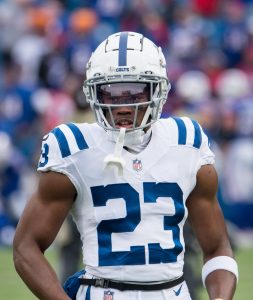 The money largely went to in-house additions, with Moore being the most significant of the re-signed contingent. For the second time, a Moore agreement raised the ceiling for slot defenders. The Colts took care of Moore when he was first extension-eligible, back in 2019. Although the former UDFA played out the deal, he has remained in form good enough to prompt another investment. Considering the uncertainty surrounding the Colts’ boundary cornerback spots, Moore locking down the slot is paramount to the team’s defensive effectiveness.
The money largely went to in-house additions, with Moore being the most significant of the re-signed contingent. For the second time, a Moore agreement raised the ceiling for slot defenders. The Colts took care of Moore when he was first extension-eligible, back in 2019. Although the former UDFA played out the deal, he has remained in form good enough to prompt another investment. Considering the uncertainty surrounding the Colts’ boundary cornerback spots, Moore locking down the slot is paramount to the team’s defensive effectiveness.
Moore, who will turn 29 next month, made an effort to secure a new contract during the 2022 offseason. With two years remaining on the four-year, $33.3MM contract, Ballard and Co. did not hand out a new one following Moore’s 2021 Pro Bowl slate. Like Chris Harris before him, Moore has operated as a high-end slot stopper who wanted to be paid closer to perimeter standouts. After a down 2022, Moore bounced back with a three-INT season that included two pick-sixes. Indianapolis ranked third in defensive DVOA in the slot compared to 25th in outside coverage. Moore’s 13 INTs from the slot position are five more than any other player since 2017; PFF ranked the 5-9 cover man 18th among all corners last season.
Also included in the top 40 on PFR’s free agent list, Stewart joined Moore in securing better terms compared to his second Colts contract. The team gave the 2017 fourth-rounder a notable raise after his 2023 season brought a PED suspension. Stewart’s six-game absence showed against the run. The Colts allowed 107.9 rushing yards per game with Stewart suited up; during his six-game ban, Indianapolis yielded 153 on the ground. Stewart, 30, also registered a career-high four sacks in 2022. Other than the PED penalty, he has not missed a game since 2019.
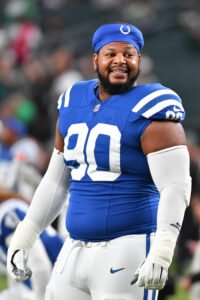 This offseason brought the first test for Ballard regarding third-contract investments; the Moore and Stewart accords showed no hesitancy existed on this front. Ballard has long prioritized homegrown talent, and these contracts show the longtime GM is willing to reward pillars approaching the end of their primes. The Colts will deploy two 30-year-old DT starters, though their DE core is much younger.
This offseason brought the first test for Ballard regarding third-contract investments; the Moore and Stewart accords showed no hesitancy existed on this front. Ballard has long prioritized homegrown talent, and these contracts show the longtime GM is willing to reward pillars approaching the end of their primes. The Colts will deploy two 30-year-old DT starters, though their DE core is much younger.
It took some time for Blackmon to come back, and the former second-round pick was not too pleased with his market. The four-year Colts starter visited the Bills and 49ers before agreeing to re-sign — likely to bolster his value for a 2025 free agency redux. Blackmon, 26 in August, was part of a safety market that rewarded high-level young talent (Antoine Winfield Jr., Xavier McKinney, Kyle Dugger) but cast other proven players (Justin Simmons, Quandre Diggs, Eddie Jackson, Jamal Adams, Kevin Byard) aside. Kamren Curl also settled for a low-level Rams deal, and it is far from certain a solid Blackmon season will lead to a value spike as macro safety assessments fluctuate.
A middle tier did form in free agency, with C.J. Gardner-Johnson (three years, $27MM), Brandon Jones (3/20) and Geno Stone (2/12) cashing in this year. Blackmon could aim for this tier in 2025, though he was already coming off a decent contract year. The Utah alum intercepted four passes, deflected eight more and recovered two fumbles in 2023, as Bradley used the versatile safety across the formation. More of the same should be expected, as Blackmon has helped cover for 2022 third-rounder Nick Cross being unable — through two years, at least — to establish himself as a reliable starter.
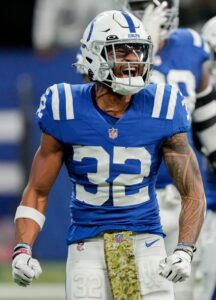 During Blackmon’s time in free agency, the Colts hosted Kareem Jackson and showed interest in former Buccaneers and Chiefs option Mike Edwards. The duo having not previously played with the Colts clearly hurt his chances during one of the NFL’s most inward-focused offseasons in recent memory. Lewis also benefited from this approach, inking a fourth Indianapolis contract, with Sanchez also now tied to a third Colts accord. Sanchez, 29, recovered from a season-nullifying injury sustained just before the 2022 campaign. After a 17-game 2023, the former UDFA is back for an eighth season in Indianapolis.
During Blackmon’s time in free agency, the Colts hosted Kareem Jackson and showed interest in former Buccaneers and Chiefs option Mike Edwards. The duo having not previously played with the Colts clearly hurt his chances during one of the NFL’s most inward-focused offseasons in recent memory. Lewis also benefited from this approach, inking a fourth Indianapolis contract, with Sanchez also now tied to a third Colts accord. Sanchez, 29, recovered from a season-nullifying injury sustained just before the 2022 campaign. After a 17-game 2023, the former UDFA is back for an eighth season in Indianapolis.
Settling in as a rotational backup capable of playing inside and outside, Lewis matched his career-high with four sacks in 2023 and established a new mark for QB hits with 13. The Colts racked up 51 sacks last season, good enough for fifth in the NFL. While Buckner, Paye, Odeyingbo and Samson Ebukam led the effort by each collecting at least seven, Lewis managed to recover from a second patellar tendon tear in two years. The former second-round pick suited up for all 17 games and scored some guaranteed money as a result, keeping Indy’s D-line core together for 2024.
Free agency additions:
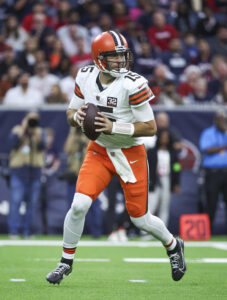 This is quite the run for Flacco, who has gone from receiving next to no interest as a 2023 free agent to the NFL’s Comeback Player of the Year to securing the most guaranteed money he has received since his final Ravens deal ended with a Broncos release. Flacco, who has banked $177MM over his career to make him a top-10 earner in NFL history, has not signed for more than $3.5MM since inking his second and final Ravens extension in 2016. Five regular-season Browns starts and a forgettable playoff outing generated interest, as the Colts needed a new backup after Minshew joined Flacco in boosting his market last season.
This is quite the run for Flacco, who has gone from receiving next to no interest as a 2023 free agent to the NFL’s Comeback Player of the Year to securing the most guaranteed money he has received since his final Ravens deal ended with a Broncos release. Flacco, who has banked $177MM over his career to make him a top-10 earner in NFL history, has not signed for more than $3.5MM since inking his second and final Ravens extension in 2016. Five regular-season Browns starts and a forgettable playoff outing generated interest, as the Colts needed a new backup after Minshew joined Flacco in boosting his market last season.
Joining the Browns after Deshaun Watson needed season-ending surgery, Flacco fared far better than he had as a Jet. The former Super Bowl MVP, who initially caught on with Cleveland via a practice squad deal, averaged 7.9 yards per attempt and threw 13 TD passes (and eight INTs) in five games — a stretch that included wins over the Texans, Jaguars and Jets. This came despite the Browns missing their starting tackles and Nick Chubb. Flacco posted four straight 300-yard showings in the Cleveland wins, driving the team to an 11-6 record and a postseason berth. Although Flacco topped 300 yards again in the wild-card round, his two pick-sixes ended the unexpected surge.
At 39, Flacco is the NFL’s second-oldest quarterback (behind Aaron Rodgers). He also expected the Browns to show interest, but Cleveland — as it shifts to a more Watson-friendly offense — preferred ex-Indianapolis FA target Jameis Winston. The Eagles also made Flacco an offer for what would have been a Philly return trip. This Colts move comes with clear risk, given Flacco’s struggles in the four seasons between his Baltimore stay and the Cleveland rebound, as Richardson came out of multiple games due to injury last season.
Read more
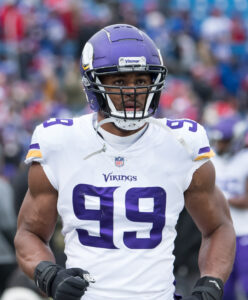 The Colts’ re-signings aside, they did pursue Danielle Hunter. Indianapolis is believed to have made the longtime Vikings cog an offer worth more than what he collected from the Texans. However, it would be surprising if the Colts’ proposal included a guarantee structure like the one the Texans provided.
The Colts’ re-signings aside, they did pursue Danielle Hunter. Indianapolis is believed to have made the longtime Vikings cog an offer worth more than what he collected from the Texans. However, it would be surprising if the Colts’ proposal included a guarantee structure like the one the Texans provided.
Hunter signed a two-year deal worth $49MM; a whopping $48MM of that is guaranteed at signing. Hunter, 29, would have been an interesting addition to a Colts team that saw Paye and Odeyingbo combine for 16.5 sacks last season. As it stands, Paye and Ebukam will retain their roles as the team’s starting DEs. But first-rounder Laiatu Latu is positioned to take over one of those spots soon.
PFF graded Davis as one of the NFL’s worst D-tackles in 2021 and ’22, assigning him a mid-pack assessment last season. The Colts certainly do not share that view, and a market formed for the ex-Dolphin’s services. Christian Wilkins and Zach Sieler‘s work overshadowed the run stuffer’s Miami contributions — Davis is even overshadowed in this section via the photo choice — but the 6-foot-7 D-tackle made 48 starts. Heading into his age-27 season, the former second-rounder will help fortify a Colts defense that will lean on eighth- and ninth-year DT starters.
Notable losses:
Once again needed for an extensive assignment, Minshew kept the Colts’ season from coming apart. The team, which had given its 2023 backup a one-year deal worth $3.5MM, went 7-6 in Minshew starts and came close to snaring a surprise playoff spot in Week 18. Minshew’s showing led to a market forming, and none of this year’s free agent QBs fetched the kind of deal the mustachioed passer did from the Raiders. The sixth-year QB secured $15MM guaranteed at signing — on a two-year, $25MM accord. The Colts were not going to approach that for a clear backup, though Minshew does not appear a lock — based on offseason reports — to beat out Aidan O’Connell for the Raiders’ starting job.
 A $15MM guarantee for a backup would be an interesting allocation of resources for the Raiders, but Minshew has made a career out of productive QB2 work. He put together a 15-9 TD-INT ratio last season, while averaging a career-low 6.7 yards per pass. Flacco is far more willing to take downfield chances, but the Colts moving from a 27-year-old arm to a 39-year-old Richardson insurance policy represents a dice roll. The Colts passed on the likes of Sam Darnold, Tyrod Taylor or a Jacoby Brissett reunion for Flacco, though the other three cost more.
A $15MM guarantee for a backup would be an interesting allocation of resources for the Raiders, but Minshew has made a career out of productive QB2 work. He put together a 15-9 TD-INT ratio last season, while averaging a career-low 6.7 yards per pass. Flacco is far more willing to take downfield chances, but the Colts moving from a 27-year-old arm to a 39-year-old Richardson insurance policy represents a dice roll. The Colts passed on the likes of Sam Darnold, Tyrod Taylor or a Jacoby Brissett reunion for Flacco, though the other three cost more.
The Colts did not make a notable move to fill their RB2 post. Moss effectively replaced Taylor during his contract- and injury-marred season, ranking seventh in rush yards over expected. The ex-Bills second-rounder brought little as a receiver but did the job on the ground (794 yards, five TDs) in his contract year. This led to the Bengals bringing him in to replace Joe Mixon, via a two-year deal worth $8MM ($3MM guaranteed). Given the Colts’ Taylor payment, it makes sense they passed on venturing into the RB middle class. But Moss’ exit does leave a void.
Indy did not draft a back, leaving former 49ers third-rounder Trey Sermon — on team No. 3 since 2022 — holding an early lead for the backup job. Other options include Evan Hull, who spent most his rookie year on IR, and Tyler Goodson — a 2022 Packers UDFA. After cruising through his college career and first two NFL seasons healthy, Taylor has battled injuries during the past two seasons. Dalvin Cook and Kareem Hunt, the latter of whom having visited the Colts last summer, are available. Ex-Saquon Barkley backup Matt Breida and former Austin Ekeler reserve Joshua Kelley are fresher options, but Sermon — via his 2022 season in Philadelphia — has now been in Steichen’s system for two seasons. That may be enough for the once-disappointing 49er RB1 hopeful.
Draft:
- Round 1, No. 15: Laiatu Latu (EDGE, UCLA) (signed)
- Round 2, No. 52 (from Panthers): Adonai Mitchell (WR, Texas) (signed)
- Round 3, No. 79 (from Jaguars through Falcons): Matt Goncalves (T, Pittsburgh) (signed)
- Round 4, No. 117: Tanor Bortolini (C, Wisconsin) (signed)
- Round 5, No. 142 (from Titans through Panthers): Anthony Gould (WR, Oregon State) (signed)
- Round 5, No. 151: Jaylon Carlies (S, Missouri) (signed)
- Round 5, No. 164 (from Lions through Eagles): Jaylin Simpson (S, Auburn) (signed)
- Round 6, No. 210: Micah Abraham (CB, Marshall) (signed)
- Round 7, No. 234: Jonah Laulu (DT, Oklahoma) (signed)
 Ballard raved about landing the draft’s first defensive player at No. 15, but the Colts did make offers to climb up in Round 1. Rumored to be after a pass catcher, the Colts attempted to climb up for Malik Nabers or Brock Bowers. It is unclear what Indy offered, but it would have cost plenty — likely a future first — for the team to leapfrog the Giants for Nabers. It is worth wondering if the Colts called the Cardinals or Chargers, who respectively dangled Nos. 4 and 5. Neither team is believed to have received a big offer, however, and the Colts tabled their WR interest until Day 2.
Ballard raved about landing the draft’s first defensive player at No. 15, but the Colts did make offers to climb up in Round 1. Rumored to be after a pass catcher, the Colts attempted to climb up for Malik Nabers or Brock Bowers. It is unclear what Indy offered, but it would have cost plenty — likely a future first — for the team to leapfrog the Giants for Nabers. It is worth wondering if the Colts called the Cardinals or Chargers, who respectively dangled Nos. 4 and 5. Neither team is believed to have received a big offer, however, and the Colts tabled their WR interest until Day 2.
Latu comes to Indianapolis after rebooting his career at UCLA. The Washington recruit completed a medical retirement before rocketing back to gridiron relevance in L.A., rebounding from his neck injury to record 23.5 sacks and 34 tackles for loss over the past two seasons. Latu became the final Pac-12 Defensive Player of the Year in the process and booked meetings with several teams. Thanks to the runs on quarterbacks and tackles, the Colts acquired a potential impact defender at 15.
Indy hosted Xavier Worthy on a pre-draft visit but ended up with the other Longhorns receiver prospect. Mitchell, who transferred from Georgia last year, did not put up big numbers until his lone Texas season. But he followed an 11-touchdown, 845-yard showing alongside potential 2025 first-rounder Quinn Ewers with an impressive Combine. Mitchell checking in at 205 pounds and clocking a 4.34-second 40-yard dash made him some money after a belated college emergence.
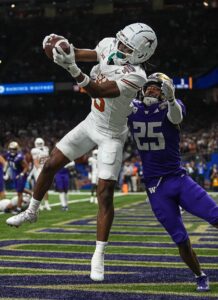 The Colts now have three second-round picks (Pittman, Mitchell, Alec Pierce) and a third-rounder (Josh Downs) among their receiving corps. This long-Pittman-dependent group now features as much depth as it has since maybe the short Hilton-Reggie Wayne years. As Indy’s WRs coach, Wayne will now attempt to develop the rookie-contract players. With Indy not having much of note at tight end, its receivers will need to do most of the heavy lifting when it comes to assisting Richardson through the air.
The Colts now have three second-round picks (Pittman, Mitchell, Alec Pierce) and a third-rounder (Josh Downs) among their receiving corps. This long-Pittman-dependent group now features as much depth as it has since maybe the short Hilton-Reggie Wayne years. As Indy’s WRs coach, Wayne will now attempt to develop the rookie-contract players. With Indy not having much of note at tight end, its receivers will need to do most of the heavy lifting when it comes to assisting Richardson through the air.
Mitchell and Pierce are set to compete for a starting role, with the 2022 second-rounder potentially set to relegate the rookie — for the time being, at least — to a WR4 role. The Colts now have their top four wideouts signed through at least 2025, with Pittman, Pierce and Mitchell all inked through at least 2026.
After moving down six spots in the second round, the Colts traded up three positions for Goncalves in Round 3. The Colts may have obtained Goncalves at a discount; the Pitt tackle prospect went down three games into his final college season. The team has placed 2022 third-rounder Bernhard Raimann as its left tackle, after struggling to fill Anthony Castonzo‘s post for a bit. Indianapolis received a breakthrough year from Raimann, with PFF slotting both he and Braden Smith the top 10 at tackle. The high-priced RT did miss seven games due to injury, however. For now, Goncalves qualifies as swing depth.
Other:
Luck retired due to the injuries he suffered; the shoulder malady that forced the former Colts franchise QB to miss all of 2017 initially occurred in 2015. Not wanting a repeat, the team shut down Richardson after it initially looked like the rookie could return later last season. But shoulder surgery transpired, capping the dual threat’s season at 173 snaps. Richardson resumed throwing in February and participated in the team’s offseason program. Though, some concern understandably emerged after the team shelved Richardson during part of its minicamp due to shoulder soreness.
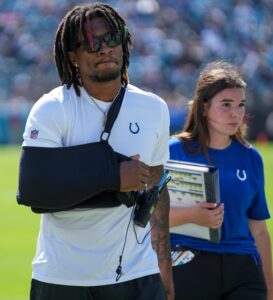 Ballard said Richardson would be full-go at camp, as the Colts — and legions of fantasy GMs — wait to see what the tantalizing prospect can put together once deployed for a lengthy stretch. But the 244-pound passer suffered injuries in three of his four games last season. The concussion and shoulder ailment came on scrambles.
Ballard said Richardson would be full-go at camp, as the Colts — and legions of fantasy GMs — wait to see what the tantalizing prospect can put together once deployed for a lengthy stretch. But the 244-pound passer suffered injuries in three of his four games last season. The concussion and shoulder ailment came on scrambles.
With the Colts eyeing Richardson because of the run-pass skillset he displayed during his one SEC starter season, it may come down to him being more cautious when he takes off. Curtailing Richardson’s run-game abilities, as he was merely a 53.8% passer during his Gators QB1 slate, would seem counterproductive.
But Richardson’s health may be the central Colts storyline heading into the season. The team approached an NFL record by starting seven Week 1 quarterbacks in seven seasons from 2017-23, with veteran stopgaps either retiring (Philip Rivers) or being jettisoned (Carson Wentz, Matt Ryan). Using the Jeff Saturday debacle as a chance to draft a QB in the top five, Ballard will see his job security hinge on Richardson. How he fares this season will play a key role in the decision-maker’s future.
Paye’s fifth-year option loomed as perhaps the toughest call to predict among the 2021 first-rounders, but the Colts now have him tied to two more fully guaranteed seasons. This gives Paye more time to develop after an inconsistent start to his career. While the Michigan product registered a career-high 8.5 sacks last season, those came on just 10 quarterback hits. Paye combined for only 18 QB hits from 2021-22. No extension talks have taken place, and Paye is not too eager to sign one. It will take a bump in production for Paye to command a lucrative second contract, and he is content on delivering that — as a better deal would undoubtedly await.
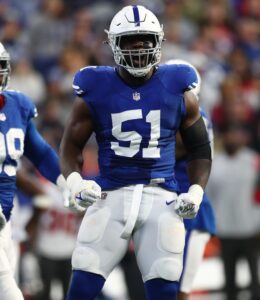 Latu’s arrival crowds Indianapolis’ DE group, though Odeyingbo is in a contract year. With Ebukam not tied to any guaranteed money over his $8MM-per-year deal’s final two seasons, the Colts will have some flexibility at DE. Latu and Paye’s contracts make them the building blocks here.
Latu’s arrival crowds Indianapolis’ DE group, though Odeyingbo is in a contract year. With Ebukam not tied to any guaranteed money over his $8MM-per-year deal’s final two seasons, the Colts will have some flexibility at DE. Latu and Paye’s contracts make them the building blocks here.
The Colts were among the many teams to look into L’Jarius Sneed‘s market, but it does not appear the franchise-tagged Chiefs corner generated too much interest. It took only a 2025 third for the Titans to acquire Sneed, and they then needed to give the latest one-contract Chiefs CB an extension that set a position record for guarantees at signing ($51.5MM). The Colts passing on that is understandable given Ballard’s hesitancy about paying outside talent big money, but the team has issues at both boundary corner posts.
JuJu Brents appears poised to start alongside Moore; the 2023 second-rounder missed eight games last season. Low-level investments Dallis Flowers (UDFA, 2022) and Jaylon Jones (Round 7, 2023) are vying for the other perimeter job. With Stephon Gilmore familiar with Bradley’s system after excelling as a 2022 rental, a reunion would be logical as a stopgap measure. Adoree’ Jackson, ahead of his age-29 season, also remains available for a Colts team that could use one more piece in the secondary.
Top 10 cap charges for 2024:
- Quenton Nelson, G: $25.2MM
- Michael Pittman Jr., WR: $18MM
- Braden Smith, RT: $16.68MM
- Ryan Kelly, C: $14.63MM
- Jonathan Taylor, RB: $10.67MM
- Grover Stewart, DT: $10.32MM
- Zaire Franklin, LB: $8.61MM
- DeForest Buckner, DT: $8.35MM
- Samson Ebukam, DE: $7.94MM
- Anthony Richardson, QB: $7.73MM
The Colts led the NFL with seven Pro Bowlers in 2021; Wentz’s issues derailed that otherwise well-built team. The Jim Irsay-driven Ryan trade in 2022 backfired quickly to drain another year from the veteran core’s primes, and the team went through a mostly Minshew-fronted ’23 slate. Many of Ballard’s pieces have been around a long time, making this offseason’s extensions and re-signings more interesting given how long it has been since the Colts made the playoffs. Time is running out for this collection to contribute to a true contender.
As it goes in the NFL, this Colts chapter will largely hinge on Richardson’s performance upon return from surgery. The unseasoned passer needing extensive development would not match up, timeline-wise, with the roster Ballard has built. Set to compete in an AFC South that appears friskier compared to most seasons in the division’s recent history, the Colts are banking on Richardson being a quick success story. This season will go a long way toward determining if their blueprint makes sense.
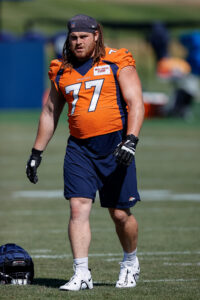 The Broncos are still using the phonetically interesting Payton-Paton power duo. GM George Paton was the point man behind three of this decade’s worst decisions — the Nathaniel Hackett hire, the Wilson trade and then the QB’s extension — but the group he drafted in 2021 has developed nicely. Paton plucked starters Patrick Surtain, Javonte Williams, Baron Browning and Jonathon Cooper in his first draft, but the biggest success story is probably a third-round guard from the Division III ranks. Meinerz has been a regular starter in Denver since midway through his rookie year, and he became the first Paton-era draftee to see his contract extended.
The Broncos are still using the phonetically interesting Payton-Paton power duo. GM George Paton was the point man behind three of this decade’s worst decisions — the Nathaniel Hackett hire, the Wilson trade and then the QB’s extension — but the group he drafted in 2021 has developed nicely. Paton plucked starters Patrick Surtain, Javonte Williams, Baron Browning and Jonathon Cooper in his first draft, but the biggest success story is probably a third-round guard from the Division III ranks. Meinerz has been a regular starter in Denver since midway through his rookie year, and he became the first Paton-era draftee to see his contract extended. Denver paying Meinerz also clouds Garett Bolles‘ future. Meinerz’s terms match Denver’s left tackle for the most lucrative O-line contract in team history, and with right tackle Mike McGlinchey also on an upper-crust contract at his position, it is fair to wonder if Bolles is entering his final season with the team.
Denver paying Meinerz also clouds Garett Bolles‘ future. Meinerz’s terms match Denver’s left tackle for the most lucrative O-line contract in team history, and with right tackle Mike McGlinchey also on an upper-crust contract at his position, it is fair to wonder if Bolles is entering his final season with the team.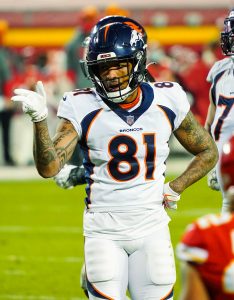 As a vested veteran, the rest of Sutton’s $13MM base salary will become guaranteed just before Week 1. But the long-running trade candidate — teams called on the former second-rounder in April and figure to again soon — was unable to secure a notable contract update, putting the pre-Payton pickup’s long-term Denver future in doubt.
As a vested veteran, the rest of Sutton’s $13MM base salary will become guaranteed just before Week 1. But the long-running trade candidate — teams called on the former second-rounder in April and figure to again soon — was unable to secure a notable contract update, putting the pre-Payton pickup’s long-term Denver future in doubt.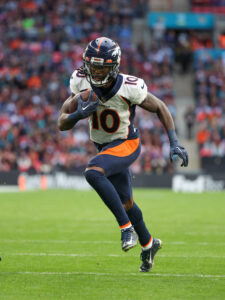 The Browns are still betting on the 2020 first-rounder unlocking upside that did not materialize in Denver. Jeudy flashed crafty route-running chops and delivered a strong finish to the 2022 season but ended his Broncos tenure 0-for-4 in 1,000-yard seasons. In the Alabama alum’s defense, the Broncos featured five play-callers (three in 2022) and mostly below-average quarterback play during the inconsistent wideout’s career.
The Browns are still betting on the 2020 first-rounder unlocking upside that did not materialize in Denver. Jeudy flashed crafty route-running chops and delivered a strong finish to the 2022 season but ended his Broncos tenure 0-for-4 in 1,000-yard seasons. In the Alabama alum’s defense, the Broncos featured five play-callers (three in 2022) and mostly below-average quarterback play during the inconsistent wideout’s career. Paton had said the Broncos planned to acquire a veteran to join Jarrett Stidham, and weeks after the team looked into Sam Darnold, the trade for Wilson was finalized. Conflicting reports about a Broncos Darnold offer emerged, but the former Jets starter preferred the Vikings. After Minnesota gave Darnold a one-year, $10MM deal, Denver reached a salary-split trade agreement for Wilson.
Paton had said the Broncos planned to acquire a veteran to join Jarrett Stidham, and weeks after the team looked into Sam Darnold, the trade for Wilson was finalized. Conflicting reports about a Broncos Darnold offer emerged, but the former Jets starter preferred the Vikings. After Minnesota gave Darnold a one-year, $10MM deal, Denver reached a salary-split trade agreement for Wilson.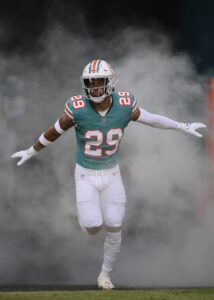 A year after big-ticket deals for McGlinchey, Powers and Allen, Denver — navigating historic cap consequences — operated conservatively in free agency. Its most notable 2024 expense was a safety that will be expected to replace Justin Simmons (or try). The Dolphins took Jones in the 2020 second round and used him as a full-time starter in 2021 and ’22, but the Jevon Holland back-line tandem partner lost a competition to DeShon Elliott last summer.
A year after big-ticket deals for McGlinchey, Powers and Allen, Denver — navigating historic cap consequences — operated conservatively in free agency. Its most notable 2024 expense was a safety that will be expected to replace Justin Simmons (or try). The Dolphins took Jones in the 2020 second round and used him as a full-time starter in 2021 and ’22, but the Jevon Holland back-line tandem partner lost a competition to DeShon Elliott last summer.
